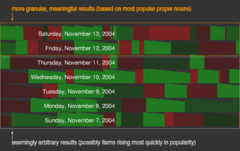tecznotes
Michal Migurski's notebook, listening post, and soapbox. Subscribe to ![]() this blog.
Check out the rest of my site as well.
this blog.
Check out the rest of my site as well.
Nov 16, 2004 8:07pm
everything is right with the universe
As I was leaving Adobe yesterday, I noticed the title of the exhibit: There Is Nothing Wrong In This Whole Wide World. I was reminded of a recent New Yorker article about Edward Stratemeyer, the brains behind Nancy Drew, the Hardy Boys, and other factory-written kids' fiction series of the past century:
Wirt gave the early volumes a "New Woman" flavor, but the core of Nancy's appeal is similar to the Hardys'. The mode is adventure with a flourish of mystery. The plot is furthered by coincidence. Nancy discovers "clues" everywhere: A tire tread? "A clue!" A ransom note with a fire-dragon crest? "It may be a clue," Nancy cries. Needless to say, these "clues" don't function as a puzzle that the enterprising reader can piece together for herself, as they do in Sherlock Holmes or Encyclopedia Brown mysteries. Instead, they are reassurances that order reigns behind the scenes. Nancy later happens to walk into a store in Chinatown and discovers that the store sells notepaper with a fire-dragon crest. Happily, the owner recalls not only that Nancy's suspect had been in the store several months earlier but also his name and build. The message is confidence-inspiring: The world is rife with crooks, but it is negotiable, and fundamentally rational. Hard work pays off. The damned remain damnedunless they repentand the wronged (long-lost maharajas' sons, heirs to candlemakers' fortunes) are restored to their rightful life at the intersection of High and Elm, among the rangy Colonials and the tall trees.
Great stuff. So much information visualization and data mining work rests on this assumption as well: there are patterns out there, recognizing them points to truth. Last week's Ten x Ten illustrates this beautifully, showing a frequently-updated batch of images gleaned from the news, owing much to Flickr's Daily Zeitgeist display of recent photos.
My own In The News project from last summer relies on this underlying order as well, so I was thrilled to see that sometime Saturday, news.google.com switched its algorithm for choosing the top ten "In The News" items back to the previous, pre-August 2004 version. The visual difference in display is striking, with a greater and more subtle range of names making the cut showing a more accurate (I hope) picture of the topics making the headlines.
When you're feeling blue about War and Politics, it's helpful to believe that the universe is negotiable, and fundamentally rational.

Comments
Sorry, no new comments on old posts.